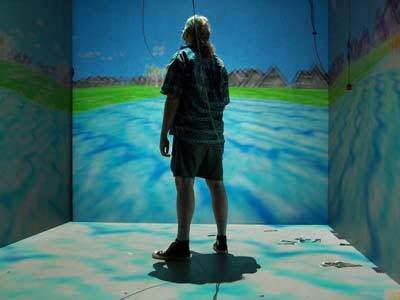This post has not been edited by the GamesBeat staff. Opinions by GamesBeat community writers do not necessarily reflect those of the staff.

Ever since I first saw Tron, I thought virtual reality (VR) would be the ultimate way to experience video games. Now that first person shooters are arguably the most popular genre, I don’t see any better time than now to make that dream come true.
All three major console manufacturers have taken the first steps towards complete, immersive gaming: Microsoft has their full-body-movement tracking sensor, Kinect; Nintendo has the Wii and its motion controller; Sony likewise has the Move but takes it a step further with 3D-visual support. Combing all their technologies into one cohesive and intuitive experience would easily bring us to VR’s doorstep today.
So what would you say if I told you this has been a put into practice for nearly 20 years?
Next year will mark the 20th anniversary of the Cave Automatic Virtual Environment (CAVE). Not only is that a redundant acronym, but it’s also a clever reference to the Allegory of the Cave in Plato's The Republic, where life-long prisoners contemplate perception, reality, and illusion.
 Developed at the University of Illinois in Chicago in 1992, the CAVE is a small room capable of giving you the feeling of complete and total immersion in a virtual environment. Early versions of the CAVE consisted of three rear-projected walls (one in front and one to each side of the participant) and one down-projected floor. It also used LCD stereoscopic shutter glasses for 3D images in conjunction with multiple motion trackers: a ceiling-mounted electromagnetic tracker monitored head movement while a Wii-like remote tracked the hand. Remember, this is way back in 1992.
Developed at the University of Illinois in Chicago in 1992, the CAVE is a small room capable of giving you the feeling of complete and total immersion in a virtual environment. Early versions of the CAVE consisted of three rear-projected walls (one in front and one to each side of the participant) and one down-projected floor. It also used LCD stereoscopic shutter glasses for 3D images in conjunction with multiple motion trackers: a ceiling-mounted electromagnetic tracker monitored head movement while a Wii-like remote tracked the hand. Remember, this is way back in 1992.
Today, the CAVE comes in several configurations, including one that is completely encapsulated with four surrounding walls and projected floors and ceilings. Adding to the experience are different methods of inputs and 3D surround sound that can change depending on the person’s location.
Utilized by universities all over the world for research, the Federal Aviation Administration for flight sims, the military for combat training, and NASA for simulated extraterrestrial navigation, the CAVE has been put through its paces and deserves to be used for what it was subconsciously intended for: video games.
What’s this…it already has?
[youtube http://www.youtube.com/watch?v=CG__PZzNfkw]
Most recently, students of a VR workshop at FH Wedel Germany transformed the popular iPhone touch game Fruit Ninja. Using the CAVE, their method of input is a Wii controller acting as the sword and an added rumbling floor for even more user feedback. While that’s all fine and dandy, I want a “core” game to play in VR.
What’s that…it’s been done as well?
As early as the turn of the century, “core” games have been played in a CAVE. I first heard about it when a friend of mine interned at NASA back in 2001. He came home with crazy stories of playing Unreal in VR. “You lucky bastard”, I thought.
Character and camera movement was controlled by infrared sensors much like the Kinect, combat was coordinated with a Power Glove-type controller, and the 3D images were viewed through lenses much like Sony’s active shutter glasses.
[youtube http://www.youtube.com/watch?v=RV2wC8TT51Y]
After watching Unreal Tournament 2003 being played in the video above [the video does not depict Matthew's friend, nor is it at NASA–Ed.] you might think the hard edges of a square room would break the illusion of a virtual environment, but it doesn’t. The sensory overload your body and mind go through while in the CAVE feels completely real when experienced firsthand.
Imagine this ultimate gaming setup: fully enclosed CAVE (four walls, the ceiling, and the floor); stereoscopic 3D goggles (glasses could fall off you head in the heat of battle); 11.2 surround sound (yup, it exists); one of those gaming vests with the air compressors to feel every bullet; a scent maker to smell the napalm in the morning; multiple Kinect sensors to precisely track your every movement; and a PlayStation Move-type machine gun to bring the pain. It sounds like a gaming room that would belong to Richie Rich, so I’m saving up now.
Costing over one million dollars, the CAVE won’t be a fixture in our homes any time soon (or probably ever), but the direction Sony, Microsoft, and Nintendo are headed could indicate where they see the eventual future of video games. And if you complained about the active involvement required for the Wii, Move, or Kinect, then I suggest you keep your lazy ass on the couch collecting Cheetos dust because full VR environments seem to be a foreseeable step in gaming — if the Singularity doesn’t come first.
Confused by all the recent cynicism plaguing the culture of the medium, Matthew and several buddies took it upon themselves to talk about the most important part of games: how fun they are. You can find this article and their other musings at Unjadeable.
